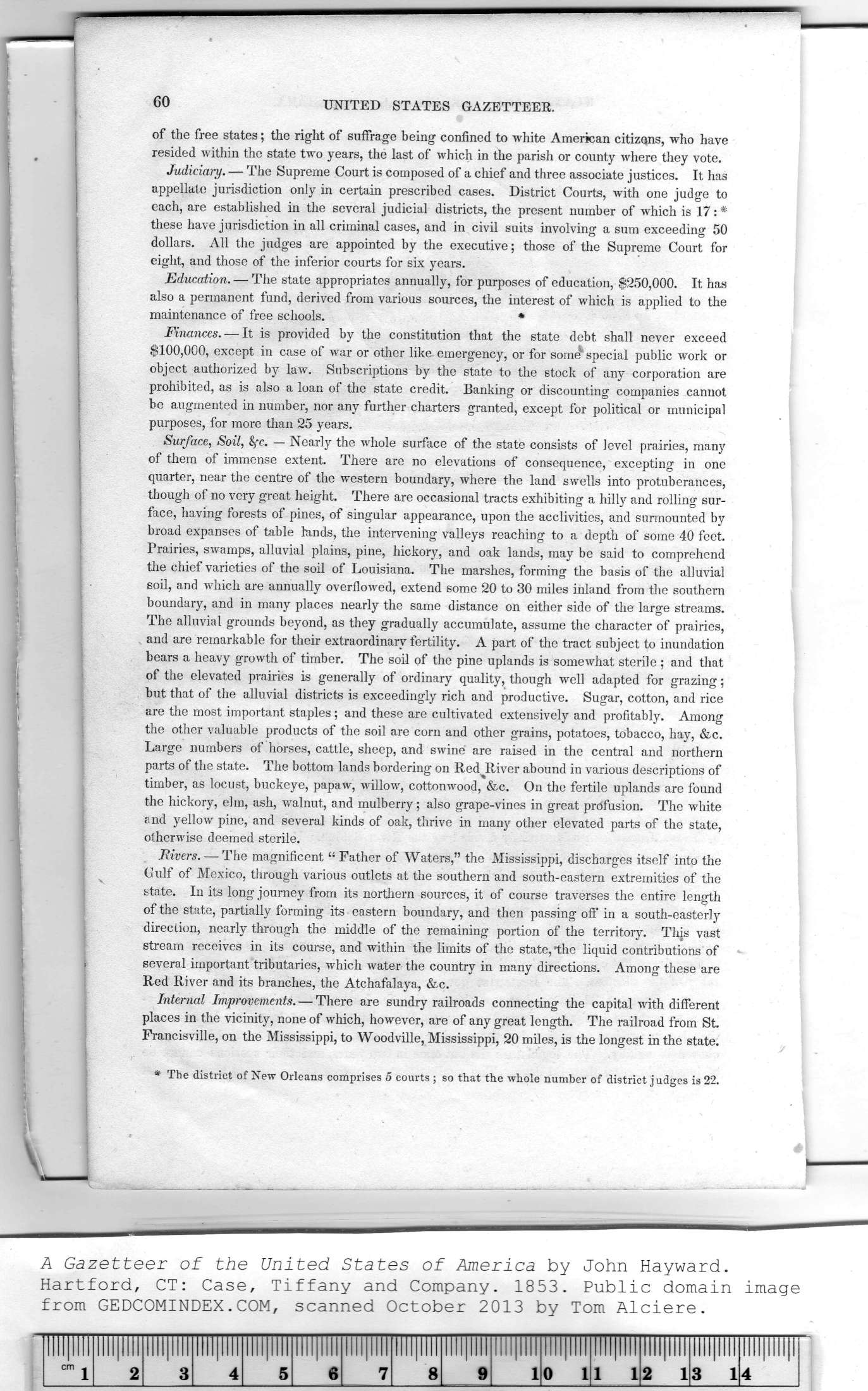|
|
Note: Ctrl and + increases the font size of the text below, Ctrl and - decreases it, and Ctrl and 0 resets it to default size.
60 UNITED STATES GAZETTEER.
of the free states; the right of suffrage being confined to white American citizens, who have
resided within the state two years, the last of which in the parish or county where they vote.
Judiciary. — The Supreme Court is composed of a chief and three associate justices. It has
appellate jurisdiction only in certain prescribed cases. District Courts, with one judge to
each, are established in the several judicial districts, the present number of which is 17: *
these have jurisdiction in all criminal cases, and in civil suits involving a sum exceeding 50
dollars. All the judges are appointed by the executive; those of the Supreme Court for
eight, and those of the inferior courts for six years.
Education. — The state appropriates annually, for purposes of education, $250,000. It has
also a permanent fund, derived from various sources, the interest of which is applied to the
maintenance of free schools. *
Finances. — It is provided by the constitution that the state debt shall never exceed
$100,000, except in case of war or other like emergency, or for some' special public work or
object authorized by law. Subscriptions by the state to the stock of any corporation are
prohibited, as is also a loan of the state credit. Banking or discounting companies cannot
be augmented in number, nor any further charters granted, except for political or municipal
purposes, for more than 25 years.
Surface, Soil, fyc. — Nearly the whole surface of the state consists of level prairies, many
of them of immense extent. There are no elevations of consequence, excepting in one
quarter, near the centre of the western boundary, where the land swells into protuberances,
though of no very great height. There are occasional tracts exhibiting a hilty and rolling sur-
face, having forests of pines, of singular appearance, upon the acclivities, and surmounted by
broad expanses of table lands, the intervening valleys reaching to a depth of some 40 feet.
Prairies, swamps, alluvial plains, pine, hickory, and oak lands, may be said to comprehend
the chief varieties of the soil of Louisiana. The marshes, forming the basis of the alluvial
soil, and which are annually overflowed, extend some 20 to 30 miles inland from the southern
boundary, and in many places nearly the same distance on either side of the large streams.
The alluvial grounds beyond, as they gradually accumulate, assume the character of prairies,
and are remarkable for their extraordinary fertility. A part of the tract subject to inundation
bears a heavy growth of timber. The soil of the pine uplands is somewhat sterile ; and that
of the elevated prairies is generally of ordinary quality, though well adapted for grazing;
but that of the alluvial districts is exceedingly rich and productive. Sugar, cotton, and rice
are the most important staples ; and these are cultivated extensively and profitably. Among
the other valuable products of the soil are corn and other grains, potatoes, tobacco, hay, &c.
Large numbers of horses, cattle, sheep, and swine are raised in the central and northern
parts of the state. The bottom lands bordering on Redjxiver abound in various descriptions of
timber, as locust, buckeye, papaw, willow, cottonwood, &c. On the fertile uplands are found
the hickory, elm, ash, walnut, and mulberry; also grape-vines in great profusion. The white
and yellow pine, and several kinds of oak, thrive in many other elevated parts of the state,
otherwise deemed sterile.
Rivers. — The magnificent “Father of Waters," the Mississippi, discharges itself into the
Gulf of Mexico, through various outlets at the southern and south-eastern extremities of the
state. In its long journey from its northern sources, it of course traverses the entire length
of the state, partially forming its eastern boundary, and then passing off in a south-easterly
direction, nearly through the middle of the remaining portion of the territory. This vast
stream receives in its course, and within the limits of the state, "the liquid contributions of
several important tributaries, which water the country in many directions. Among these are
Red River and its branches, the Atchafalaya, &c.
Internal Improvements. — There are sundry railroads connecting the capital with different
places in the vicinity, none of which, however, are of any great length. The railroad from St.
Francisville, on the Mississippi, to Woodville, Mississippi, 20 miles, is the longest in the state.
* The district of New Orleans comprises 5 courts ; so that the whole number of district judges is 22.
|
